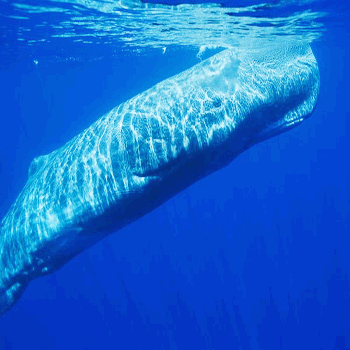Sperm Whale

Common Name: Sperm Whale
Scientific Name: Physeter macrocephalus
Sperm Whale - Description
Sperm whales, Physeter macrocephalus are the largest of the odontocetes (toothed whales) and the most sexually dimorphic cetaceans, with males considerably larger than females.The sperm whale is distinguished by its extremely large head, which takes up to 25 to 35% of its total body length.
It is the only living cetacean that has a single blowhole asymmetrically situated on the left side of the head near the tip. Sperm whales have the largest brain of any animal (on average 17 pounds (7.8 kg) in mature males), however, compared to their large body size, the brain is not exceptional in size.
Sperm Whale - Diet
There are between 20-26 large conical teeth in each side of the lower jaw. The teeth in the upper jaw rarely erupt and are often considered to be vestigial. It appears that teeth may not be necessary for feeding, since they do not break through the gums until puberty, if at all, and healthy sperm whales have been caught that have no teeth.
Sperm Whale - Behaviour
Sperm whales are mostly dark gray, but oftentimes the interior of the mouth is bright white, and some whales have white patches on the belly. Their flippers are paddle-shaped and small compared to the size of the body, and their flukes are very triangular in shape. They have small dorsal fins that are low, thick, and usually rounded.
Sperm Whale - Habitat
Sperm whales tend to inhabit areas with a water depth of 1968 feet (600 m) or more, and are uncommon in waters less than 984 feet (300 m) deep. Female sperm whales are generally found in deep waters of low latitudes . These conditions generally correspond to sea surface temperatures greater than 15°C, and while female sperm whales are sometimes seen near oceanic islands, they are typically far from land.
Sperm Whale - Life History
During the past 2 centuries, commercial whalers took about 1,000,000 sperm whales. Despite this high level of "take", the sperm whale remains the most abundant of the large whale species. Currently, there is no good estimate for the total number of sperm whales worldwide. The best estimate, that there are between 200,000 and 1,500,000 sperm whales, is based on extrapolations from only a few areas that have useful estimates.
Location or Region Found
Sperm whales inhabit all oceans of the world. They can be seen close to the edge of pack ice in both hemispheres and are also common along the equator, especially in the Pacific. Sperm whales are found throughout the world's oceans in deep waters between about 60° N and 60° S latitudes. Their distribution is dependent on their food source and suitable conditions for breeding, and varies with the sex and age composition of the group.
Sperm whale migrations are not as predictable or well understood as migrations of most baleen whales. In some mid-latitudes, there seems to be a general trend to migrate north and south depending on the seasons (whales move poleward in the summer). However, in tropical and temperate areas, there appears to be no obvious seasonal migration.
 Deep Sea Crabs
Deep Sea Crabs